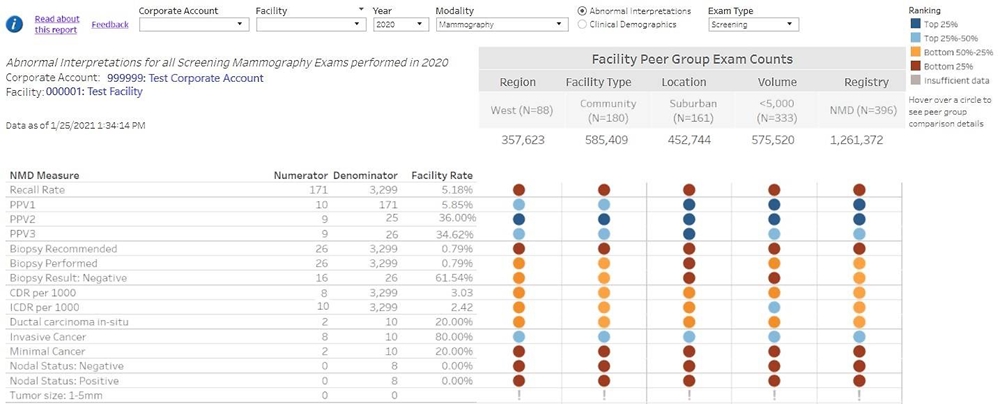The ACR National Mammography Database (NMD) leverages data that radiology practices are already collecting and provides comparative information for national and regional benchmarking. Participants receive quarterly feedback reports that include important benchmark data such as cancer detection rates, positive predictive value rates and recall rates.
The NMD is adding new breast imaging measures focused on timeliness of follow-up actions as well as new interactive reports that provide valuable feedback to help you focus on opportunities to improve quality of care for your patients.
New Breast Imaging Measures
The NMD will be adding two new measures to the registry to help participants assess the timeliness of patients receiving follow up on breast imaging findings. The two measures are:
- Screening to diagnostic workup: Reports timeliness of screening mammography exams with abnormal findings to performance of diagnostic mammography.
- Diagnostic exam to biopsy procedure: Reports timeliness of diagnostic mammography with biopsy recommendation to performance of biopsy procedure.
These two new breast imaging performance measures will be reflected in NMD feedback reports in the second quarter of 2021.
The ACR® is also collaborating with the American College of Surgeons and the National Accreditation Program for Breast Cancer to report findings on the timeliness from abnormal screening mammography to diagnostic mammography and then to positive biopsy and, finally, surgery.
Interactive NMD Reports
NMD participants now have access to three interactive reports that provide helpful insight about facility performance. The online, “real-time” reports incorporate filters that allow users to view general performance trends, drill down to explore exam-level data and ensure the quality and completeness of data being submitted to the NMD.
The three new reports include:
- NMD Measures - Aggregate Reports. Provides in-depth information about the registry as a whole and data NMD facilities can use to identify their screening program’s strengths and areas for improvement. Report highlights include:
- The Peer Comparison Report displays up-to-date data about a facility’s performance compared with both peer facilities and all registry participants.
- An Annual Trend Report displays a facility’s ranking compared to the entire registry across multiple years with interactive functionality to view facility averages compared to the registry median for a selected measure.
- For corporate accounts with multiple facilities, a Facility Comparisons Report enables side-by-side performance comparison across facilities within their corporate structure.

NMD Measures — Aggregate Report. Click the image to view a larger version.
- Data Quality Reports. Enables users to quickly validate that the data sent to the registry are accurate and complete using a set of reports.
- The Summary of Records report includes the history of data uploaded within the past 365 days for a selected facility.
- The Errors/Inconsistencies report presents data elements with incorrect or inconsistent data.
- The Data Frequencies report provides the frequencies of selected data elements (e.g., number of exams, biopsy procedures, exam indication and lesion classification).
- The Patient Demographics report shows exam frequencies for patient sex and age, as well as height and weight (2.x file formats only).
- The Indication and Assessment report shows bar charts for combinations of indications, including exam and assessment category.
- Exam Search Report. Features an interface that enables users to select and download data elements to track performance trends of interest for one or more facilities within a given date range.
Keep in mind, facilities that have upgraded to an NMD 3.0 version, which is based on the most recent BI-RADS® edition (2013), benefit from obtaining additional report insights. NMD users with version 3.0 (or higher) can more accurately assess exam results with double interpretations and combination exams (for example, a mammogram and ultrasound). Learn more about transitioning to NMD version 3.0.